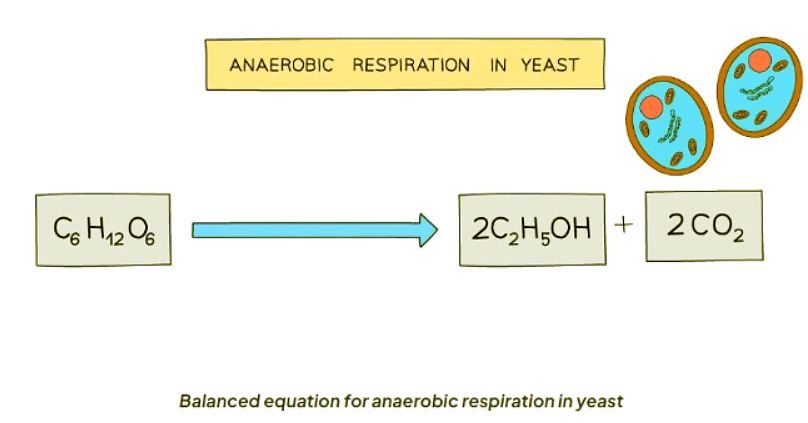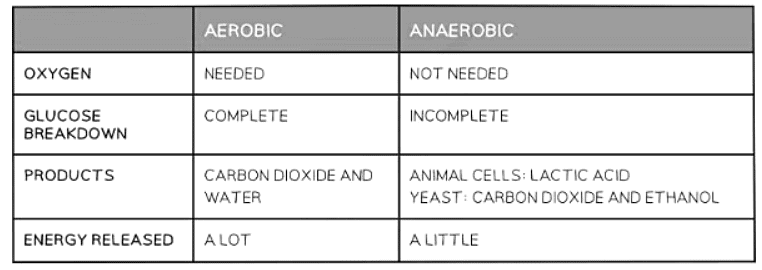Year 11 Exam > Year 11 Notes > Biology for GCSE/IGCSE > Anaerobic Respiration
Anaerobic Respiration | Biology for GCSE/IGCSE - Year 11 PDF Download
Anaerobic Respiration - Respiration Without Oxygen
- Anaerobic respiration is a process that does not require oxygen. It involves the chemical reactions in cells that break down nutrient molecules to release energy without the use of oxygen.
- Unlike aerobic respiration, which fully breaks down glucose, anaerobic respiration is an incomplete breakdown of glucose, resulting in the release of a relatively small amount of energy for cell processes.
- The products produced during anaerobic respiration vary depending on the organism in which the process is occurring.
- It is essential to understand the specific equations for anaerobic respiration in humans (animals) and the microorganism yeast.
Anaerobic Respiration in Muscle Cells
- Anaerobic respiration primarily occurs in muscle cells during intense exercise.
- During vigorous physical activity, muscles require more energy compared to when at rest or during moderate exercise.
- Muscle cells face limitations in receiving sufficient oxygen for aerobic respiration during intense exercise.
- In situations where oxygen availability is limited, glucose is partially broken down without oxygen, leading to the production of lactic acid.
- Although less energy is released during anaerobic breakdown of glucose, there is still stored energy within lactic acid molecules that cells can utilize.

Anaerobic Respiration in Yeast
- We utilize the byproducts of anaerobic respiration in yeast for various purposes:
- Bread Making: In this process, the carbon dioxide produced is responsible for causing the dough to rise.
- Brewing: Here, the ethanol produced imparts the alcoholic nature to beer, while the carbon dioxide adds fizz.
Examples:
- Bread Making: The carbon dioxide generated during anaerobic respiration in yeast is crucial for the rising of dough, creating fluffy bread.
- Brewing: The ethanol produced gives beer its characteristic alcoholic content, while the carbon dioxide contributes to its effervescence.

Balanced Chemical Equation for Anaerobic Respiration
- The balanced chemical equation for anaerobic respiration in yeast is:

Anaerobic Respiration & Oxygen Debt: Extended
- Lactic acid accumulation in muscle cells reduces their pH, making them more acidic.
- This acidity can potentially disrupt cellular enzymes, necessitating its removal.
- Muscle cells expel lactic acid into the bloodstream, where it is subsequently absorbed by liver cells during circulation.
- Within liver cells, lactic acid undergoes oxidation, yielding carbon dioxide and water.
- Consequently, post-exercise, heightened breathing and heart rates persist to facilitate the transport of lactic acid to the liver and ensure ample oxygen supply for its oxidation.
- This process is termed "repaying the oxygen debt."
Comparing Aerobic & Anaerobic Respiration
Comparing types of respiration:

Question for Anaerobic RespirationTry yourself: Which organism primarily undergoes anaerobic respiration during intense exercise?View Solution
The document Anaerobic Respiration | Biology for GCSE/IGCSE - Year 11 is a part of the Year 11 Course Biology for GCSE/IGCSE.
All you need of Year 11 at this link: Year 11
|
110 videos|158 docs|34 tests
|
FAQs on Anaerobic Respiration - Biology for GCSE/IGCSE - Year 11
| 1. What is anaerobic respiration? |  |
Ans. Anaerobic respiration is the process of producing energy without the use of oxygen. It is commonly used by cells when there is a lack of oxygen available.
| 2. How does anaerobic respiration occur in muscle cells? |  |
Ans. In muscle cells, anaerobic respiration produces lactic acid as a byproduct when oxygen is not available in sufficient quantities to support aerobic respiration. This process helps provide energy for muscle contractions during periods of intense exercise.
| 3. What is the role of anaerobic respiration in animals? |  |
Ans. In animals, anaerobic respiration is essential for providing energy when oxygen levels are low, such as during strenuous physical activity. It allows cells to continue producing ATP, the cellular energy currency, even in the absence of oxygen.
| 4. How does anaerobic respiration occur in yeast? |  |
Ans. Yeast cells undergo anaerobic respiration through a process called alcoholic fermentation, where glucose is broken down into ethanol and carbon dioxide. This process is used by yeast in the production of bread, beer, and wine.
| 5. What is the balanced chemical equation for anaerobic respiration? |  |
Ans. The balanced chemical equation for anaerobic respiration in muscle cells is: C6H12O6 → 2C3H6O3 (lactic acid) + energy. This shows the conversion of glucose into lactic acid and energy in the absence of oxygen.

|
Explore Courses for Year 11 exam
|

|
Signup for Free!
Signup to see your scores go up within 7 days! Learn & Practice with 1000+ FREE Notes, Videos & Tests.
Related Searches
















